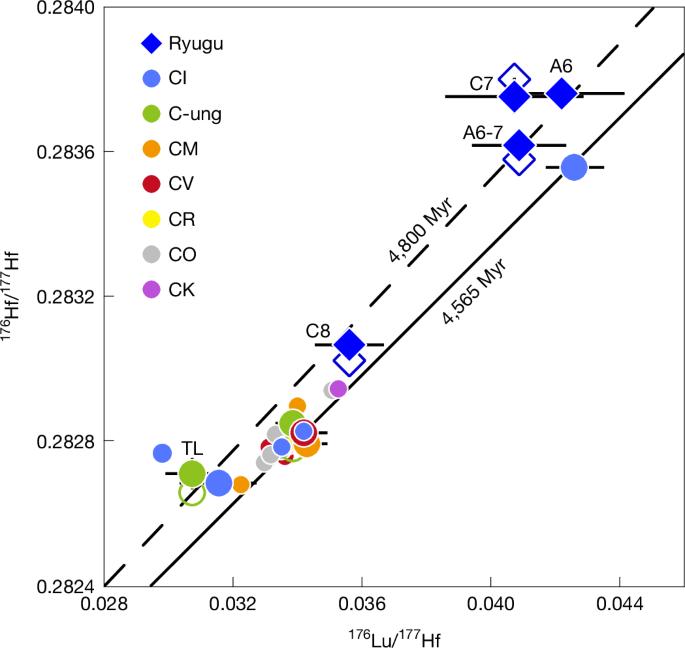Late fluid flow in a primitive asteroid revealed by Lu–Hf isotopes in Ryugu
IF 48.5
1区 综合性期刊
Q1 MULTIDISCIPLINARY SCIENCES
引用次数: 0
Abstract
Carbonaceous asteroids are the source of the most primitive meteorites1 and represent leftover planetesimals that formed from ice and dust in the outer Solar System and may have delivered volatiles to the terrestrial planets2–5. Understanding the aqueous activity of asteroids is key to deciphering their thermal, chemical and orbital evolution, with implications for the origin of water on the terrestrial planets. Analyses of the objects, in particular pristine samples returned from asteroid Ryugu, have provided detailed information on fluid–rock interactions within a few million years after parent-body formation6–11. However, the long-term fate of asteroidal water remains poorly understood. Here we present evidence for fluid flow in a carbonaceous asteroid more than 1 billion years after formation, based on the 176Lu–176Hf decay systematics of Ryugu samples, which reflect late lutetium mobilization. Such late fluid flow was probably triggered by an impact that generated heat for ice melting and opened rock fractures for fluid migration. This contrasts the early aqueous activity powered by short-lived radioactive decay, with limited fluid flow and little elemental fractionation12. Our results imply that carbonaceous planetesimals accreted by the terrestrial planets could have retained not only hydrous minerals but also aqueous water, leading to an upwards revision of the inventory of their water delivery by a factor of two to three. Analysis of samples from the asteroid Ryugu provide evidence of late fluid flow in a carbonaceous asteroid, indicating that such bodies may have retained two to three times more water than previously thought.

龙宫Lu-Hf同位素揭示的原始小行星晚期流体流动。
碳质小行星是最原始陨石的来源,代表了太阳系外由冰和尘埃形成的残余的星子,可能向类地行星输送了挥发物。了解小行星的含水活动是破译它们的热、化学和轨道演化的关键,对类地行星上水的起源也有影响。对这些物体的分析,特别是从小行星“龙宫”(Ryugu)带回的原始样本,提供了母体形成后几百万年内流体-岩石相互作用的详细信息。然而,小行星水的长期命运仍然知之甚少。基于Ryugu样品的176Lu-176Hf衰变系统,我们提供了一颗碳质小行星形成后超过10亿年的流体流动证据,这反映了晚期的镥动员。这种晚期的流体流动可能是由撞击引发的,撞击产生了热量,使冰融化,并打开了岩石裂缝,使流体运移。这与早期由短暂放射性衰变驱动的水的活动形成了对比,当时流体流动有限,元素分馏很少。我们的研究结果表明,由类地行星吸积的碳质星子可能不仅保留了含水矿物,而且还保留了含水水,这使得它们的供水量增加了2到3倍。
本文章由计算机程序翻译,如有差异,请以英文原文为准。
求助全文
约1分钟内获得全文
求助全文
来源期刊

Nature
综合性期刊-综合性期刊
CiteScore
90.00
自引率
1.20%
发文量
3652
审稿时长
3 months
期刊介绍:
Nature is a prestigious international journal that publishes peer-reviewed research in various scientific and technological fields. The selection of articles is based on criteria such as originality, importance, interdisciplinary relevance, timeliness, accessibility, elegance, and surprising conclusions. In addition to showcasing significant scientific advances, Nature delivers rapid, authoritative, insightful news, and interpretation of current and upcoming trends impacting science, scientists, and the broader public. The journal serves a dual purpose: firstly, to promptly share noteworthy scientific advances and foster discussions among scientists, and secondly, to ensure the swift dissemination of scientific results globally, emphasizing their significance for knowledge, culture, and daily life.
 求助内容:
求助内容: 应助结果提醒方式:
应助结果提醒方式:


